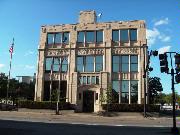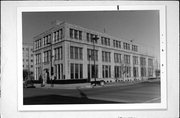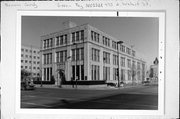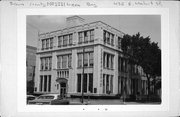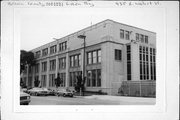| Additional Information: | A 'site file' exists for this property. It contains additional information such as correspondence, newspaper clippings, or historical information. It is a public record and may be viewed in person at the Wisconsin Historical Society, State Historic Preservation Office.
Formerly 431 E. Walnut (1957 Sanborn-Perris Map). Excellent, intact NeoGothic Revival combination newspaper office and printing plant. Terra cotta is used to side the exterior walls on the north, south, and east facing facades while the east [???] facing facade is sided in brick. The building has a crenellated parapet covered in the same terra cotta siding as the main walls. Two-story-tall panelled pilasters divide the exterior walls into bays, each of which has three tall 2/2 lite double hung windows in the first floor and three smaller 2/2 lite windows above in the second floor. The spandrels between the first and second floors contain terra cottapanels reprsenting a blind arcade done in high relief after a manner sometimes found in Tudor and Jacoeban architecture. The spandrel above the second floor window is covered in terra cotta tiles representing stylized shields. The south facing facade is symmetrical and contains the entrance with its segmental sided opening and surround topped by five small fixed rectilinear windows. The attic story of the building uses the same pattern as the first two floors, but with smaller 1/1 lite double hung triple window groups.
TEXTURED SURFACE DUE TO NEOCLASSICAL ORNAMENTAL PANELS SEGMENTAL ARCH OVER ENTRY GB PRESS GAZETTE OPENED JUNE 1915, MERGING GB GAZETTE (1886) & FREE PRESS (1914). In photo and/or map codes, (F) stands for Fox River Valley Survey. Negatives filed with survey project.
A later, very large modern addition is attached to the northwest facing corner of the building and contains the current printing plant. This addition is two stories tall, is flat roofed, and is sided with brick.
The Green Bay Press-Gazette has been the predominant newspaper in the city for the bulk of the century. It was formed in 1915 with the merger of the Free Press, owned by Victor L. Minahan, and the Gazette which, at the time, was the only Republican paper in then predominantly Democratic Green Bay.
HAER INVENTORY (07/1979):
The Green Bay Press-Gazette began publication on June 29, 1915. It was a merger of two earlier newspapers, the Green Bay Gazette, founded in 1886, and the Free Press, started in 1914. The founders of the Press-Gazette were Andrew Turnbull, John Kline, and Victor Minahan. In 1924 the firm employed 40 people and had a circulation of 6500 papers, with 5 linotype machines. This building was built in 1924 as a two-story structure and in 1956 a third story was added.
The building is constructed of reinforced concrete and tile blocks. With few exceptions, the windows have a reflective backing making them look much like mirrors. The main entrance has an arch with radiating voussoirs. The roof is flat and the parapet is decorated with medallions. The structure measures 72' x 189'.
2017-NRHP District Nomination
Constructed in 1924, this building was purpose-built to serve as the office and printing plant of Green Bay’s principal newspaper. The building’s neogothic revival design is the product of architect Max Schober, a partner in what was then the Foeller-Schober architecture firm (later Foeller, Schober, and Berners). As originally constructed, the building was two stories in height and six bays wide along its east (towards N. Madison Street) and west façades. Two bays were added at the north end of the building in 1937 and a third story was added in 1955. In 1969 a large printing plant was constructed off the building’s northwest corner (see 129 N. Madison). The newer printing plant is connected to this building by a small, two-story, rectilinear hyphen with glass curtain walls on the north façade. Despite these changes, the Press-Gazette Building retains an exceptionally high degree of [historic material] and continues to serve as the home of the Press-Gazette.
The north, east, and south facades of the building are clad in terra cotta. The first bay of the west façade, nearest Walnut street, is also clad in terra cotta and, like the south and east façades, has a crenelated parapet, but the remainder of this façade is clad in cream color brick with a continuous brick parapet.
The building’s east and south façades are those that have the most visual impact as they are the principal, street-facing sides (N. Madison and Walnut streets). The east, south, and west façades are divided into bays by two-story paneled pilasters. On the principal east and south façades, each bay has three tall windows in the first floor and three smaller windows in the second floor. These windows are all modern replacements and have a horizontal rail at mid-height that gives the windows the appearance of being a 1/1 style (as opposed to the earlier 2/2 and 3/3 lite windows). Terra cotta panels with elongated quatrefoils carved in relief separate the first and second story windows. Terra cotta panels above the second story windows feature nine or more stylized shields, the total number depending on the width of the bay. A band of stylized square rosettes runs above the shields, with a single rosette situated between each pair of shields and a partial-width rosette at the extreme ends.
The attic story matches the style of the original building and continues the three-window arrangement per bay except in the two northern bays along the east façade where there are no attic windows. The attic windows are shorter than those in the second story and are single pane with no horizontal rail at mid-height. Attic windows are situated above terra cotta panels featuring another Tudor-inspired relief design, which are in turn above a small cornice that separates the second and third stories. A crenelated parapet tops the walls and features a panel with a single shield between each bay, just above the top of the third story windows.
The building’s principal entrance is located on the symmetrical south façade along Walnut street. The entrance has a narrow rectangular window to either side, all of which is situated under a segmental arch. The spandrels each have a single quatrefoil in relief. Five small, fixed, rectangular windows sit just above the arch and spandrels.
The north façade of the building has attic windows and one second-story window at left, but much of the remainder of this façade is covered by the two-story hyphen that connects this building with the 1969 printing plant at 129 N. Madison. The west façade has a roughly central entrance facing a parking lot. The four bays to the south of the west-facing entrance follow the regular pattern of three windows per bay in all three stories. The fenestration above the west-facing entrance and in the three bays to the north is somewhat irregular, with each bay lacking the individual symmetry found in bays previously described. The hyphen extends to the west from the north-west corner of this façade. |
|---|
| Bibliographic References: | (A) Abrahams, Paul P. Industrial Survey of Brown County. Industrial Sites Historical Survey. Unpublished manuscript on file, Historic Preservation Division, State Historical Society of Wisconsin.
(B) Sanborn-Perris Map Co., Inc. Fire Insurance Map of Green Bay, Wisconsin. New York, 1957.
(C) Green Bay Press-Gazette, Obtituary, March 20, 1965.
(D) Betsy Foley, ed., Green Bay: Gateway to the Great Waterway, Woodland Hills, CA, 1973, p. 79.
(E.) "Gazette, Free Press Consolidated in 1915," GREEN BAY PRESS-GAZETTE, Sunday July 27, 1969, tabloid "Growing Bigger to Serve Better," p. 2.
(F.) Jack Yuenger, "Expansion Has Been Great in Press-Gazette's Last Decade," GREEN BAY PRESS-GAZETTE, Aug. 3, 1957, Greater Green Bay Progress Edition, p. A-18, col. 1.
(G.) Timothy Heggland et al., Green Bay Intensive Survey Final Report (Green Bay: Redevelopment Authority, 1988), 259.
(H.) Sanborn Fire Insurance Company, “Green Bay,” 1936 (with updates through 1968). |
|---|

